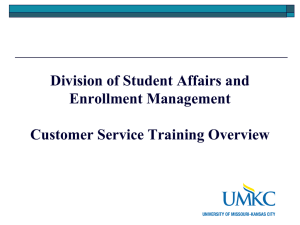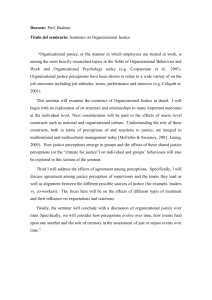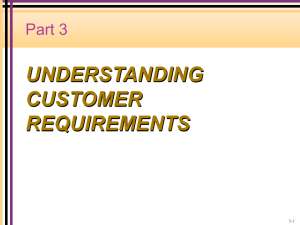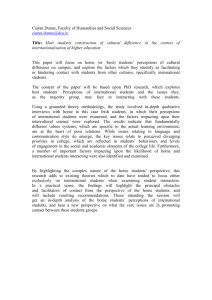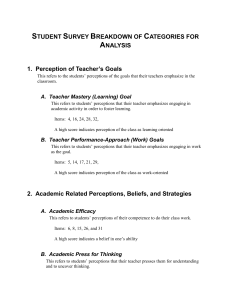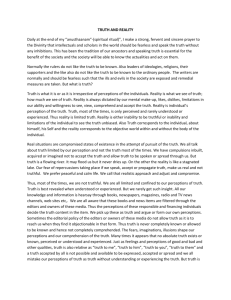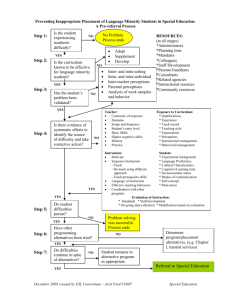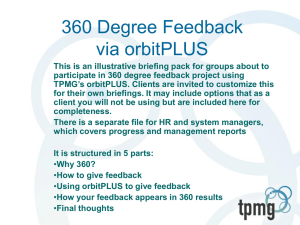MBA Project Report on Service quality of banks
advertisement
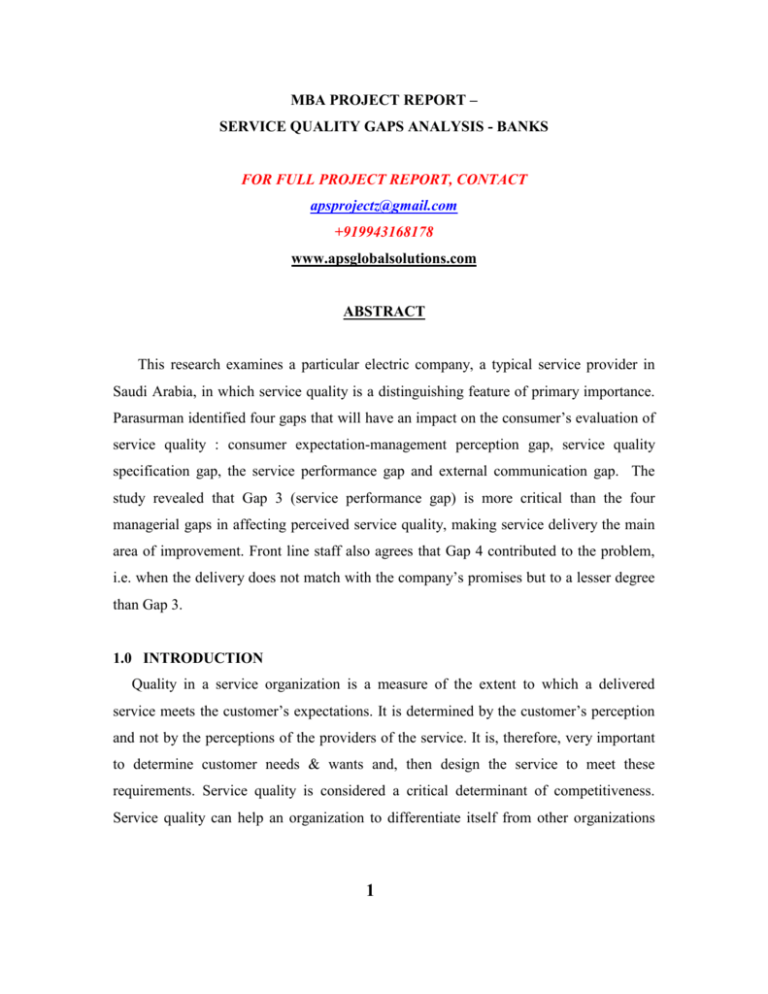
MBA PROJECT REPORT – SERVICE QUALITY GAPS ANALYSIS - BANKS FOR FULL PROJECT REPORT, CONTACT apsprojectz@gmail.com +919943168178 www.apsglobalsolutions.com ABSTRACT This research examines a particular electric company, a typical service provider in Saudi Arabia, in which service quality is a distinguishing feature of primary importance. Parasurman identified four gaps that will have an impact on the consumer’s evaluation of service quality : consumer expectation-management perception gap, service quality specification gap, the service performance gap and external communication gap. The study revealed that Gap 3 (service performance gap) is more critical than the four managerial gaps in affecting perceived service quality, making service delivery the main area of improvement. Front line staff also agrees that Gap 4 contributed to the problem, i.e. when the delivery does not match with the company’s promises but to a lesser degree than Gap 3. 1.0 INTRODUCTION Quality in a service organization is a measure of the extent to which a delivered service meets the customer’s expectations. It is determined by the customer’s perception and not by the perceptions of the providers of the service. It is, therefore, very important to determine customer needs & wants and, then design the service to meet these requirements. Service quality is considered a critical determinant of competitiveness. Service quality can help an organization to differentiate itself from other organizations 1 and gain a competitive advantage. Superior service quality is a key to improved profitability. Saudi Consolidated Electric Company in the Eastern Province (SCECO-EAST) is the largest electrical utility in Saudi Arabia. It serves the Eastern region from Hafr albatin and its villages north to Salwa on the Qatar border, and from the Arabian Gulf east to the border of central province. The main system’s peak demand for 1998 was 7703 MW while the generation capacity amounted to 8773 MW. In 1998, power was supplied to 19,424 new customers. This figure, representing a 3.9 % increase over the previous year, has brought the total number of customers by the end of 1998 to 519,558. The percentages of power consumption by customer type are: Saudi Armco 26%, Industrial 25%, SCECO-Central 17%, Residential 20%, Government 7% and Commercial 5 %, bringing total power sales to 46,407,108 Megawatts-hour. SCECO-EAST is one of these utilities that hoped that it would be able to provide better service if it promoted a greater understanding of service quality issues in this industry. SCECO-East applied SERVQUAL, a methodology for measuring customers’ perceptions of service quality. The perceived quality is the customer’s feelings about the quality of the service. It determines the extent of the customer’s satisfaction. It is the results of comparing the prior expectations with the actual service received. The prior customer expectation is the established image of what will be received when the consumer requests a service, while the actual quality is the real level of service quality provided. The actual service is determined and controlled by the provider of the service. It is, therefore, necessary to set standards of service quality characteristics, i.e. determinants of service quality (Ghobadian et al. 1994). SCECO-East measured level of service quality by asking their customers about their expectations and perceptions of actual performance over determinants of service quality i.e. tangibles, reliability, responsiveness, assurance and empathy. The mismatch between customer expectation and perception of actual service constitute SERVQUAL scores. The mean score for the expectations component was 6.25 and for perceptions is 5.59 on a seven-point scale. SERVQUAL scores, which can be ranged from –6 to +6 on which 2 zero implies that consumer perceptions and expectations coincide, negative values imply perceptions fall short of expectations and positive values imply perceptions exceed expectations, has a mean of –0.65. The mean of -0.65 for the SERVQUAL measure implies that on average respondents’ perceptions fell short of their expectations, which is logical if expectations are considered ideal. The average minimum value of SERVQUAL for all customers is –4.76, while the maximum is 2.81. Lower negative gap scores imply high level of perceived service quality, i.e. customer perceptions come closer to matching expectations. SCECO-East took matters a step further to investigate factors behind this lag between customers’ expectations and their perceptions. The primary objective of the research is to investigate the quality shortfall within the SCECO-East organization and between SCECO-East and its customers and then improve the understanding of the characteristics, structure and the performance of SCECO-East. Several quantifiable measurements were made by surveying SCECO-East managers and staff. This paper describes a detailed survey and analysis in the light of the model put forward by Parasurman , Zeithaml and Berry (PZB) . The purpose of the empirical study is to offer a conceptual framework summarizing the unique characteristics and culture at SCECO-EAST organization, to report the findings of the survey conducted to measure gaps in services provided, to review potential problems from an empirical study and to offer recommendations exploring the ways in which SCECO-East may identify and exploit opportunities to improve its services. The paper will measure the four gaps in perceptions, including the gaps within the service provider and between the client and the organization (service quality gap model). Recommendations regarding each of the gaps will be proposed after analyzing the collected data. Methodology Two surveys have been conducted for this project: one amongst SCECO-East's supervisors in the company and the second amongst the contact personnel (front line staff). The front-line staff and the principals and the supervisory staff were selected at 3 random. For the frontline staff survey, a sample size of 200 ( about 40 % of total population) was chosen. A total of 117 (59 %) completed questionnaires were collected for the current research. For supervisory staff, a random sample of 20 principals and supervisors that have contacts with customers was selected. Of the original 20 questionnaires, 12 (60 %) were returned and usable. The Frontline staff questionnaire contained statements capturing the essence of what literature suggests are specific variables of antecedents of gaps related to service performance and difference between service delivery and external communication. Similarly, supervisory questionnaire contained statements to predict the difference of management perceptions of customer expectations and specific variables of antecedents for the wrong service quality standards. Respondents were asked to indicate on a scale of 1 (very low) to 7 (very high) the extent to which they felt each item was the performance of SCECO-East. Mean score for each specific variable was calculated by averaging all responses in the sample size for that variable. Analysis Gap 1 is defined as the managers’ perceptions of customer expectations minus the customers’ expectations. It measures how well the service provider knows what his customers expect. Table 1 compares principals’ perceptions of customers’ requirements with those declared by customers over five service quality dimensions namely: Tangibles, Reliability, Responsiveness, Assurance (competence, courtesy, credibility, security) and Empathy (access, communication, understanding of the customer) which is defined below: 1. Tangibles : These include the appearance of physical personnel, facilities, equipment, communications, use of appropriate materials, etc. Tangibles are more important in high contact services, i.e. conditions of the buildings. 2. Reliability : It is the ability to provide the promised service dependably and accurately. For example, in the case of electrical utilities, this means fewer or no power outages to customers. 4 3. Responsiveness : It is the ability to deal effectively and promptly with customer requirements and complaints. For example, in the case of electrical utilities, prompt repair of power outages and providing temporary supply during outages. 4. Assurance: Knowledge, experience, courtesy and readiness to maintain client confidence and trust. 5. Empathy : It involves caring and providing individualized attention to customers. It is interesting that there is agreement between customers and principles on several dimensions. The slight disparity indicates that the service quality needs of customers are not being fully identified for dimensions of tangibles, assurance and empathy. A positive score for reliability indicates that management are greatly concerned about this dimension and consider it as the most important with respect to customers. Empathy, which is rated with least expectation score by both principals and customers, indicates that both management and customers do not expect individualized and personal attention by contact employees during service delivery. There may be two plausible reasons for this. First, SCECO-East is considered as a government monopoly agency and customers would not expect personalized attention by SCECO-East employees. Secondly, SCECO-East principals think that services provided to customers are standards in nature and there is no chance for customization. Management Perceptions of Customer Expectations Table 2 reports mean scores of management perceptions of customers’ expectations. The total mean item for the expectations component of 21 features is 6.11. This measure is lower than the mean reported by customers which is 6.25, meaning that SCECO-East management slightly underestimates customers’ expectations. Judging from the average responses for managers’ perceptions of customer expectations for the 21 service features, two features received extremely high average responses, indicating that SCECO-East management felt them to be of most importance to the customers. These are: providing services at the time they promise to do (a reliability feature) and having convenient operating hours (an empathy feature). While all scores are high (more than 5.50 on a scale of 7), two features were rated by principles as the least important to customers. 5 These are: employees being neat in appearance (a tangible feature) and having customers’ best interest in mind (an empathy feature). Comparing these results of management perception of customers’ expectations with those obtained earlier from customers, we could have the following inferences: 1. SCECO-East management underestimates more than 50% of 21 service features. This is shown in minus signs in the fourth column. The higher the negative difference, the more gap in knowing customer expectations by the management. 2. While some items rated highest by customers, SCECO-East management rated these items with lowest scores. One example is “employees to be neat in appearance”, rated by customers as the second essential feature, while SCECO-East managers rated it the least important feature. 6 References Cronin , J. Joseph , Taylor Steven A(1992); “ Measuring Service Quality ; A Reexamination and Extension” , Journal of Marketing , Vol. 56 (3) , PP. 55 - 68 . Cronin , J. Joseph , Taylor; Steven A. (1994); “SERVPERF VERSUS SERVQUAL : Reconciling Performance - Based and Perceptions - Minus - Expectations Measurement of Service Quality” , Journal of Marketing , Vol. 58 , PP.125 - 131. Ghobadian, A.; Speller, S. ; Jones, M. (1994); “Service Quality Concepts and Models”, International Journal of Quality & Reliability Management, Vol. 11 No. 9 , PP. 43 - 66. Jannadi, O., Al-Saggaf, H. (2000); “Measurement of Quality in Saudi Arabian Service Industry”, International Journal of Quality and Reliability Management, Vol. 17, No. 5. Kelley, Scott W. ; Donnelly, James; Skinner, Steven J. (1990); "Customer Participation in Service Production and Delivery", Journal of Retailing, Vol. 66 No.3, PP. 315 335. Parasuraman, A. ; Berry, Leonard L. ; Zeithaml, Valarie A. (1991); “Refinement and Reassessment of the SERVQUAL Scale” Journal of Retailing , Vol. 67 No.4, PP. 420 – 450. 7

